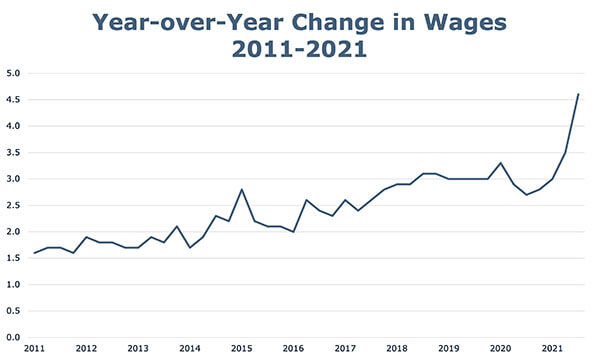Employees Have Never Had More Leverage in this Job Market
If Employers Aren't Engaging Them, They’ll Find One That Will
Actalent's Economy & Labor Market Brief: December 2021
Two steps forward, one step back. Whiplash. Tug of war.
However you describe it, the sentiment seems applicable to all things in life right now: don't get too used to anything because it probably will change. School districts are hinting at remote learning, if they haven't returned to it already; businesses are quieting on back to office plans; restaurants are closing or reducing hours again without enough staff to stay open.
This push and pull is evident in key economic metrics, too. One on hand, the 199,000 increase in payrolls in December was half of what economists predicted. On the other hand, unemployment fell to 3.9%, the lowest rate since before the pandemic hit.
Yet job openings remain near a record 11 million.
Except there are more than 3 million workers who left the workforce and are no longer counted in unemployment numbers anymore.
Wages increased 4.7 percent over one year ago.
But inflation surged 7 percent in December, the fastest pace in forty years.

Note: Private Sector; Source: Labor Department
For every push, there seems to certainly be a pull.
Connecting the Dots
What's Temporary, and What Will Last?
With all things—job quits, low labor force participation rates, the supply chain, schooling, the pandemic, new ways of working— it's hard to predict what will be temporary, and what will last.
Here's What We Know Right Now:
1. Employees have never had more leverage in this job market. If current employers aren't giving employees reasons to stay, they've got plenty of bargaining power to find one that will.
Aaron Sojourner, a labor economist at the University of Minnesota calls the metric the “labor leverage ratio”, which looks at the ratio of people who quit their job, versus those who were let go. Employee-initiated quits are at their highest levels in two decades—more than 3x as many workers quit than were fired in December— demonstrating that companies don't want to lose employees, but they are.
2. Employers will need to find new ways to get important work done. Between low unemployment rates, 3 million workers missing from the workforce, unfilled job openings at 10.5 million, we can hope to experience some recovery as COVID-19 abates. However, even if that's the case, the talent shortages in engineering and sciences labor categories will remain elevated well after the pandemic is over:
-Between the scarcity of talent, the increase in demand, and the rapid pace at which sciences and engineering skillsets change, companies are reevaluating job descriptions, upskilling existing employees, and realizing the benefits of strategic partnerships with talent solution providers as they shift away from hiring FTEs to identifying critical skillsets needed to get important work done.
-The U.S. Bureau of Labor Statistics (BLS) reports that STEM occupations are expected to grow 8.0 percent through 2029, more than twice all other occupations.
-BLS projects the labor force participation rate will continue its downward trend from 61.7 percent in 2020 to 60.4 percent in 2030, due to lower birth rates and aging baby boomer population.
-Job occupations with the fasted projected employment growth over the next decade include healthcare, computer and mathematic occupations, medical research, renewable energy installers/technicians—a.k.a, Engineering + Sciences.
3. COVID has expanded our vocabulary. Maybe we're not the first to use this term, but we'll claim it: Tenured Whiplash. It's in response to this recent article in the Wall Street Journal pointing out that even employees who haven't left their job are arguably onto their third job in two years—the job they had before the pandemic, the job they had during it, and the job they now have as we return to some kind of normalcy. The other term we're hearing is shybrid—the result of pushing return-to-office plans, and then pulling them back again, which only adds to the pile of scenarios that cause us to feel unsure of what to believe.
We can't say how 2022 will look, but we can guarantee it won't look like December 2019. Federal Reserve Chairman Jerome Powell is preparing to enact measures to rein in inflation that include a series of interest rates hikes and halt of bond purchases. The Supreme Court blocked the vaccine mandate for private businesses but upheld it for health care workers. Container ships are still stranded at sea. Interest in remote and hybrid work persists. And we're all holding our breath as Omicron sends workplace attendance rates (and probably payroll gains) further plummeting in January.
Kathryn Edwards, a writer for the Wall Street Journal, said it best, "The labor market in 2022 will reflect what workers learned from their experience, but also how employers and policy makers choose to respond."
Employees have leverage in this market. They also have a much clearer idea of what they're looking for in an employment experience. Companies that respond with compelling work, caring management, flexible options, and competitive compensation will go a long way toward engaging employees and giving them the stability—and the hope— we all crave.
Actalent's December 2021 Jobs Report synthesizes information from a variety of sources including the United States Bureau of Labor Statistics survey results, media reports, industry intelligence, company earnings reports, and external labor market data. The full set of data is included as a companion to this article.
If you'd like more information on the data presented, or have questions about the information provided in this report, please contact our team at: content@actalentservices.com.


